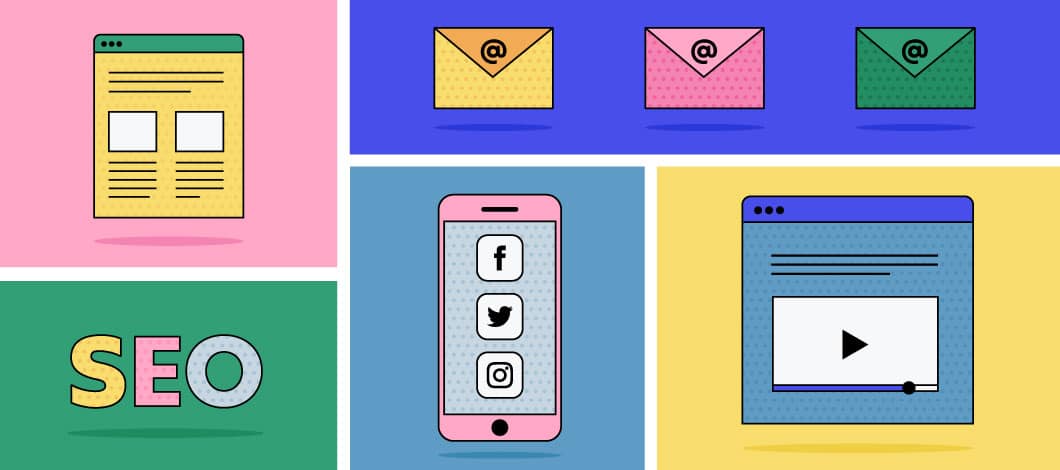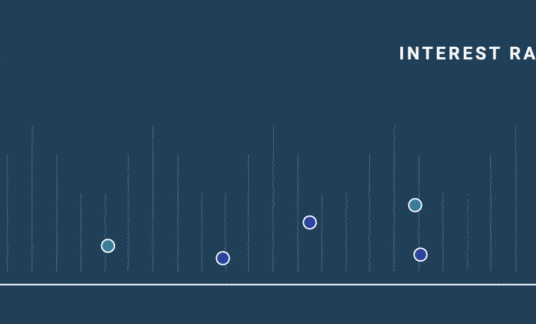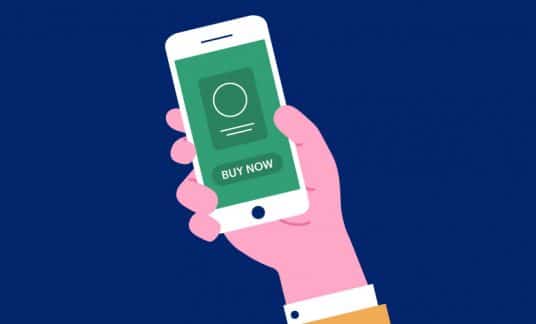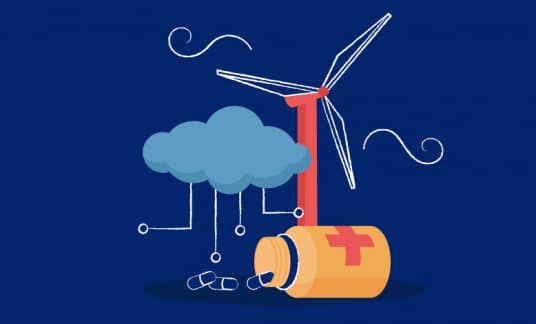Companies in every sector have taken to the web to meet people where they are. So it’s no surprise that digital marketing is all around us.
We don’t need to yell it from the rooftops. Just think of the last time you Googled a topic from your mobile device, clicked into an article that topped the search results page and then watched a video embedded in the post. You may have even fulfilled a call to action and signed up for alerts or a newsletter – all in one sitting.
But despite the ubiquitous influence of digital, 44% of businesses engaged in online marketing still lack a defined digital strategy.
Whether you currently have a plan in place and want to build on it or are seeking to start one from scratch, we’re here to help.
In this guide, we’ll go over what digital marketing entails and review top marketing tactics and tools you can start using today. We’ll also show you how to create a marketing strategy and campaign designed to increase your digital presence.
What Is Digital Marketing?
Digital marketing builds brand awareness on the internet and the devices people use to access the web. With worldwide online users in the billions, the internet is a wellspring of potential customers.
As with all marketing efforts, the function of digital marketing is to build audiences and move them along the buyer journey. Companies do this in a couple ways.
Outbound Marketing
Outbound marketing, or push marketing, is a way to find new customers who aren’t actively seeking your products. If you reach users who find your marketing and product appealing, they’ll engage with your brand.
Examples of outbound marketing designed to increase brand awareness and generate leads include cold emails, email marketing, search ads, display ads, video ads and social media ads.
Inbound Marketing
Inbound marketing, or pull marketing, is used to draw audiences organically by answering their questions and solving their problems. This type of marketing is credible and often results in a brand earning followers and eventually loyal customers.
With inbound marketing, users are choosing to engage with your brand. Forms of inbound marketing include blogs, social media, content marketing and search engine optimization (SEO).
Digital Marketing and the Buyer Journey
The ultimate goal of any marketing is to move prospects along the buyer journey – guiding them from awareness to consideration to decision. It’s critical to create specialized marketing efforts for each stage of the buyer journey.
For example, during the awareness stage users are looking to solve a problem or find an answer to a question. It’s during this stage that a potential prospect becomes aware of a brand. As such, market your brand by addressing a pain point and offer helpful content, such as an educational blog, e-guide or a checklist. Incorporate keywords such as improve, prevent and risks.
Throughout the consideration stage, users want to know about you, your products and services and how they can benefit from them. Solution and “how to” guides and product comparisons are useful marketing tools here, as are product videos, webinars or podcasts. Good keywords to use at this stage include tool, solution, provider and service.
Once in the decision stage, users have a broad understanding of the solution they’ll pursue and are making evaluations of products or services that might be a good fit. Product or vendor comparisons also work well at this stage, as do vendor reviews, case studies, helpful data and even free trials. Use keywords such as pros and cons, compare and test.
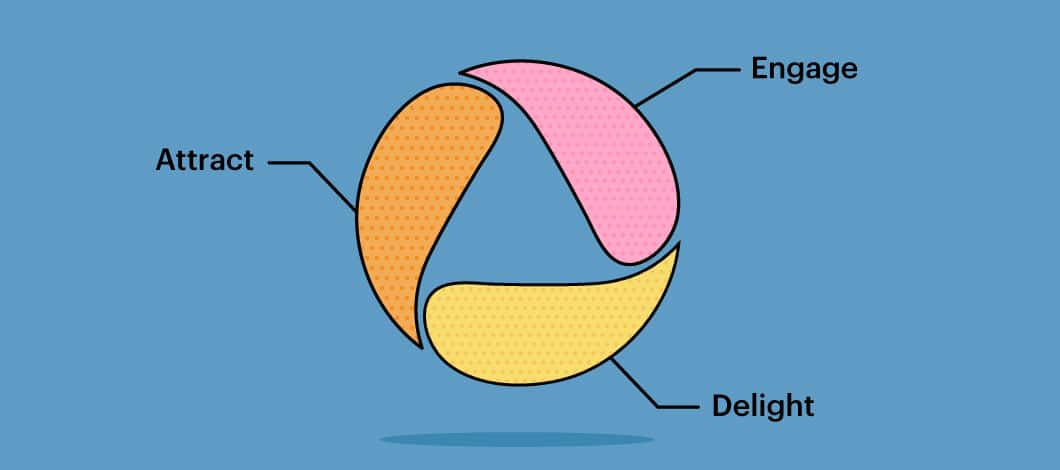
Digital Marketing Framework
While outbound marketing can often be seen as casting a wide net to generate leads, inbound marketing takes special consideration to build relationships with targeted prospects. To do this, marketers implement a 3-prong framework for success: attract, engage and delight.
The goal? Provide value to the right audience at the right time and they’ll convert from prospects to clients to brand ambassadors.
Attract
Before anything else, you need to appeal to people who want what you’re selling. Identify your target clientele and create buyer personas that align with the audience you’re aiming to attract.
Once you’ve done this, focus on the marketing initiatives and platforms that will generate the most traction. Attract your audience with strategic ads, videos, blogs, social media posts and content.
Engage
Attention and personalization are key to engaging your audience and forming relationships that extend beyond the first impression and build trust.
Ways to foster engagement and manage leads effectively include sending personalized emails, sharing relevant content and employing marketing automation.
Delight
Delighting users means maintaining a connection and continuing to engage them in a memorable way, even after a sale. By doing so, you’ll stay top of mind for repeat business as well as referrals, which can initiate the “attract, engage and delight” cycle all over again.
At this phase you can better understand your audience by using techniques such as attribution reporting and social media listening, in which you monitor social channels for mentions of your brand, specific topics or keywords and feedback that can provide valuable insight.
Additionally, after a customer makes a purchase, send a satisfaction survey to get feedback you can use to continue improving.

The Modern Digital Marketing Mix
Businesses today use a mix of digital marketing tools and techniques to increase brand awareness, customer acquisition, lead generation and nurturing, website traffic and customer loyalty.
SEO
Search engine optimization is a sustainable way to increase traffic organically. It’s also highly rated for return on investment (ROI). According to Smart Insights “Managing Digital Marketing in 2020” report, 37% of marketers project SEO to offer the highest ROI, with 40% expecting a medium return.
Today, modern SEO is not about optimizing for search engines, but the user experience. Gone are the days of writing content overrun with keywords for the sake of keywords alone. SEO writers and analysts consider intent as well as strategic keywords.
When users Google a phrase or word, what answers are they hoping their query will return? Creating high-quality content that provides valuable information to target audiences is at the forefront of SEO-optimized content, along with:
- Ensuring a great user experience
- Gaining quality backlinks
- Improving site loading times
- Fixing broken links
- Optimizing for mobile
- Refreshing and updating content
Content
Content marketing is among the top marketing activities that will make the largest commercial impact, according to Smart Insights. The focus of content marketing is on producing content of value and relevance to your intended audience.
Content isn’t limited to written copy, such as blogs, e-books and guides. It can refer to any of the following:
- Case studies
- Checklists
- How-to articles
- Infographics
- Memes
- Podcasts
- Testimonials
- User-generated content
- Videos
- White papers
Video
In the U.S., 85% of people who surf the web watch online video content. What’s more, viewing averages account for more than an hour of screen time a day, so it’s no surprise that video is the top choice of media within digital content strategies.
Popular ways to employ video for marketing purposes are for promotional efforts and brand storytelling. Other types of video marketing include:
- Company culture videos
- Customer case studies
- Interviews
- Product demonstrations
- Product reviews
- Social engagement
- Tutorials
- Video blogs/vlogs
- Webinars
Videos can be live-streamed or pre-recorded and posted on social media, embedded in a website or shared via email.
Promotional emails are the most popular types of emails marketing professionals invest in, followed by account sign-ups, behavioral emails and editorial emails, according to HubSpot’s 2020 report. Marketers use several methods to improve email performance, among the most popular of which is message personalization.
Other techniques include:
- Automated emails
- Engaging copy
- Email design
- Mobile-friendly emails
- Segmented subscriber lists
Distribution frequency is another factor, with approximately 65% of marketers sending customers 2-5 emails per week, according to HubSpot.
Paid Media
Paid media is another form of digital content marketing that can drive exposure by reaching new prospects or re-engaging leads or past customers.
In many cases, ads can be specially targeted to certain audiences depending on their interests, location, demographics and devices.
According to HubSpot’s 2020 “Not Another State of Marketing Report,” 68% of marketers indicated that paid advertising is extremely important to their larger marketing strategy.
Paid media can take the form of:
- Banner ads
- Display ads
- Paid search results
- Pay-per-click advertising
- Pop-up ads
- Sponsored social media posts
- Video advertising
Social Media
Overall, Facebook towers over other social platforms when it comes to ROI, with Instagram and Twitter coming in second and third. And according to Gary Vaynerchuk, best-selling author, CEO of VaynerMedia and popular podcaster, LinkedIn, though often underutilized for marketing, is the Facebook of 2012.
Marketers often post on social channels 3-4 times weekly, with photos and imagery being the most popular forms of social posts for marketers. They might also share links to new blog posts, interact with followers or provide links to downloadable content or webinars.
Other types of social media marketing posts include partnership posts, text-based posts and videos.
Influencers
We can’t discuss social media marketing without touching on influencer marketing, which is projected to be a $15 billion industry by 2022, according to Business Insider.
A recommendation from a popular social media personality can result in increased brand awareness and traffic. Quality influencers have high engagement rates and followers who fit your target demographic. They should promote your product in a manner that’s authentic for them.
Specialized digital marketing tools, such as BuzzSumo and BuzzStream, can make it easy to research and find an influencer who aligns with your brand and voice. Done well, influencer marketing can have impressive returns, up to $18 in earned media value for every dollar spent, according to Influencer Marketing Hub.
What Is a Digital Marketing Strategy?
A digital marketing strategy is a plan to achieve certain comprehensive or long-term goals leveraging online channels and techniques, such as those mentioned above.
You can think of it as a roadmap of routes you expect to take to reach your final destination.
Digital marketing channels can include paid media, owned media (e.g., company blog, website, email) or earned media (e.g., reviews, social shares).
Basic Marketing Strategies with Examples
Types of digital marketing strategies include:
- Building communities on social media
- Ensuring mobile responsiveness across marketing efforts
- Focusing on next-generation technology (e.g., chatbots, Internet of Things)
- Exploring engagement on other social media platforms
What Are Digital Marketing Tactics?
When it comes to digital marketing, there’s often some confusion between marketing strategy vs. tactics. Digital marketing tactics are action-focused and refer to the promotional efforts marketers take to execute against their strategies and meet their goals.
For example, if your strategy is to be considered a subject matter expert in your field, hosting webinars and podcasts and creating downloadable e-books could showcase your breadth and depth of industry knowledge.
Other examples of tactics used within a digital marketing campaign include:
- Case studies
- Co-branding
- Blogging
- Content republishing
- Conversion rate optimization
- Endorsements
- Event hosting
- Gamification
- Live streams
- Marketing automation
- Partnerships
- Personalization
- Referrals
- Research
- Testimonials
How to Create a Digital Marketing Strategy
Now that we’ve answered the question “What is a digital strategy?” and explored marketing tactics, we’ll look at how to create a marketing strategy for digital.
In addition to identifying your audience and their challenges, you’ll need to create a plan to address and outline the specific actions you’ll take to overcome them.
Here are the key steps for developing a marketing strategy and plan for your business.
1. Create Buyer Personas
To be an effective marketer and resonate with those who’ll benefit most from your product, you need to know who you’re targeting. Perhaps equally as important is knowing how your product can alleviate a pain point or fulfill a need.
Buyer personas are fictional characters you name (e.g., Michael Marketing) with a background that represents those of your ideal customers. Some of the best ways to get the details you need to build personas are by conducting surveys and interviews of prospects.
Reach out to existing clients and others who fit into your target audience as well as your sales and client relations teams to conduct your research. You can also look for trends in your current contact database as well as use analytics tools for certain information, such as location.
In addition to uncovering your target audiences challenges and goals, consider determining the following:
- Age
- Education level
- Gender
- Income
- Interests
- Job title
- Location
- Priorities
Keep in mind, the specific information you choose to research for your persona may differ depending on whether you’re in the business-to-business or business-to-consumer space.
2. Performing a Competitive Analysis
Along with knowing who your prospects are is knowing who your competitors are. You need to have a firm understanding of their services, pricing and sales strategies and marketing tactics.
You may find weaknesses that you can exploit to develop a better product or market more effectively.
Ask the following questions when conducting your analysis:
- What are their strengths?
- What are their areas of opportunity?
- What does their content strategy look like?
- How are they ranking for content you want to rank for?
- What keywords are they targeting?
- What types of marketing strategies are they employing?
- What social media channels do they focus on?
- What does their social media strategy entail?
- How do their followers engage with them?
Digital marketing tools can help you conduct a competitive analysis. For example, SEMrush lets users find competitor keywords, view competitor analytics, get audience insights and perform competitor brand monitoring, among other features.
3. Define Your Objectives
Before your digital marketing plan can come together, you need to know what you’re looking to achieve. Outlining your goals and objectives as well as time frame for reaching them will ensure you’re one step closer to getting there. Develop objectives that align with your company’s overall goals for business.
According to a CoSchedule survey of more than 3,000 marketers, those who set goals were 376% more likely to report success. But don’t just set any goals. Instead, focus on creating SMART goals — those that are specific, measurable, attainable, relevant and timely.
4. Evaluate Your Efforts to Date
You can further fine-tune your goals and find out what aspects of your digital marketing are working by taking a good look at your current assets and channels. You likely have a lot to analyze, so get organized. Itemize each aspect of your existing digital marketing efforts and budget details for each.
Once you have that, sit down with your marketing team, review your analytics and assess how your paid, earned and owned media and the digital marketing platforms you utilize are performing. Compare where you are now to where you want to be based on your goals.
Ask the following for each item:
- How is it performing?
- What results are we seeing?
- How much is it costing?
- How is the return on investment?
- What’s working?
- What’s not working?
- How does this effort fit into my overall strategy?
By auditing your efforts, you can clearly see what areas need improvement and what changes you can make to build your brand. You can also determine if you’d like to remove certain efforts from your strategy altogether.
5. Build Your Plan
Now that you have your goals set and have evaluated your efforts to date, you can build your digital marketing strategy and develop a timeline for execution. Use all of the research you’ve gathered up to this point and document how you plan to achieve your goals over the long term.
What Is a Digital Marketing Campaign?
While a digital strategy is focused on macro goals, a digital marketing campaign consists of the actions used to reach smaller, shorter-term goals within the broader strategy.
Similar to how we compared digital marketing strategy to a roadmap, you can think of a campaign as a single day on a long road trip. It includes all the turns and maneuvers you make in that day as you get closer and closer to the endpoint on your map.
For example, if your campaign strategy is to generate more leads via social media, your campaign might be a strategic use of top-performing channels that reach your target audience and a combination of content that engages them, posted at times that will have the highest impact.
For business-to-business, this could mean posting informative blog posts, case studies and podcasts on LinkedIn and Facebook at strategic days and times throughout the week, for instance, Wed. at noon for LinkedIn and Monday at 9 a.m. for Facebook.
How to Create a Marketing Campaign for Digital
Creating a digital marketing campaign is similar to creating a digital marketing strategy, though on a more micro scale.
In addition to defining your audience, you’ll need to define your goals as well as how you will measure them. You’ll also need to establish a campaign timeline.
Then work on developing a concept for your campaign and creating your messaging. After which, you’ll select the best media and distribution outlets for the project.
Creating a digital marketing campaign also requires developing a realistic budget. You’ll need to understand what amount of marketing spend will still deliver a profit.
Digital Marketing Campaign Examples
Airbnb
Leveraging owned media, Airbnb launched the goodwill digital campaign “Host a Hero” to help house first responders worldwide during the COVID-19 pandemic.
The company has partnered with its housing hosts to provide 100,000 frontline workers with accommodations. Healthcare workers and other first responders can apply for temporary housing to maintain social distancing from family members and remain close to work.
Airbnb accepts donations to help fund these stays, with easy-to-use “Donate Now” and “Share” buttons on its site, with 100% of proceeds going to relief efforts.
Fast Capital 360
At Fast Capital 360 we’ve focused our digital campaign efforts on building a reputation of credibility and trust. How?
We developed client testimonials and customer success videos. These case studies demonstrate how specific business owners approved through the Fast Capital 360 platform used their financing to improve their circumstances.
We’ve also built our online ratings over time, earning 5 stars on TrustPilot, based on nearly 800 customer reviews.

How to Measure Success
Your goals will help you determine how you measure success.
Identify a starting point for each key performance indicator (KPI) metric, which you can use as a comparison for future analysis. Then set up KPI dashboards to monitor performance and see where you stand.
Examples of metrics you can track include:
- Average session duration
- Bounce rate
- Click-through rate
- Conversion rate
- Cost per acquisition
- Cost per click
- Cost per conversion
- Email open rate
- Mobile traffic
- Most visited pages
- Overall website traffic
- Page conversion rate
- Pageviews
- Lifetime customer value
- New visitors vs. returning visitors
- ROI
- Social media engagement rate
- Traffic by source
Decide which KPI metrics you will track and how you’ll use them to quantify your digital marketing accomplishments.
-
Lacking the resources you need to develop and execute your digital marketing strategy? See how business financing can help.



